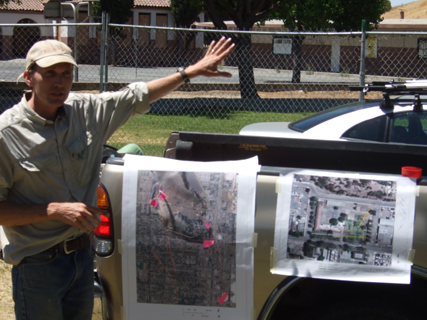
Geologists are not ready to bless or condemn downtown site
Geologists cutting trenches through the proposed site of a
downtown Hollister courts complex may have found evidence of
earthquake faults, about 20 local officials learned this week.
But the prospect of faults does not doom the downtown courthouse
project.
Geologists are not ready to bless or condemn downtown site
Geologists cutting trenches through the proposed site of a downtown Hollister courts complex may have found evidence of earthquake faults, about 20 local officials learned this week.
But the prospect of faults does not doom the downtown courthouse project.
Geologist Steve Thompson of William Lettis and Associates, the geological consultants conducting the seismic survey, said he and his co-workers are not ready to make a call just yet.
Thompson stood in front of a pickup plastered with charts and photos on Monday, talking about what he described as an ideal site for sleuthing for earthquake evidence. His firm cut two trenches up to 19 feet deep at the site of the old Fremont School, off Fourth Street between Monterey and West.
“The sediments we’ve exposed are beautiful layer cake sediments,” Thompson said. “It’s great news for the study because we have … the right stratigraphy to say, ‘yes we do’ or ‘no we don’t have a fault.'”
Thompson said geologists cut through layers of soil to a level that was on the surface during the Holocene Epoch, about 11,000 years ago. To a trained eye, the layers tell the story of the Hollister region. For example, Thompson said they reveal a series of floods from the San Benito River.
They also reveal something considerably more mysterious.
“We located some features we continue to evaluate,” Thompson said. “These are unusual, clay-filled fractures, clay that’s very different from the surrounding structures. In some cases, this clay is associated with faulting. The alternative is that the clay is not associated with faulting – what we call a classic dike.”
County Supervisor Anthony Botelho pressured Thompson for a more definitive verdict, asking if findings could be a “deal killer” for the $34 million courthouse project.
Thompson explained that a California law, the Alquist Priolo Act, dictates “special study zones” along active faults.
Hollister is riven by the Calaveras Fault, and Thompson traced the track of two branches. “The west branch special study zone ends at West Street and the east trace special study zone ends at Monterey Street,” Thompson said. “We’re surrounded on all sides by special study zones, but we’re outside” at the courthouse site.
The Alquist Priolo Act contains guidelines that say buildings intended for human occupancy must not be located on faults, Thompson said.
While several locations along the trenches contained clay layers that Thompson’s firm continues to study, one spot located near the west end of the site appears to show a section of layers that has sunk beneath neighboring strata. It is that spot that “captures the most interest” of geologists, Thompson said.
Lettis and Associates may do further trenching in an attempt to find the trace of what that location suggests may be a fault. If one is found, the court building can be located on that site in a configuration that avoids the actual fault, he said.
After his presentation Thompson and a handful of other geologists allowed those present to clamber down ladders into the trenches, which are pocked with nails flying bits of colored tape to mark various features.
Hollister City Manager Clint Quilter, himself an engineer, studied the trenches with special interest. His interest runs deeper than the fact that the city is paying for the survey in a bid to keep local courts downtown. He once worked as a mining engineer in Nevada.
Courts administrator Gil Solorio spent about 15 minutes walking along the floor of one of the trenches.
The news that the courts complex may be possible in the fault-filled downtown area brightened Hollister Councilwoman Eugenia Sanchez.
“It’s hopeful,” she said. “We want to be very sure of what we’re doing, but I know the citizens really want the courthouse in this area.”
Thompson said his firm’s evaluation will continue for at least another month, and findings will need to be prepared before they are presented to local officials for review. That process means that a definitive determination about the location of San Benito County’s new courts complex remains months away.









